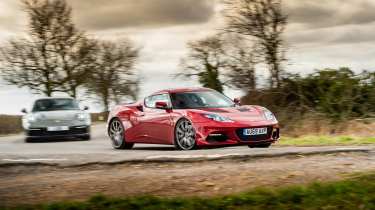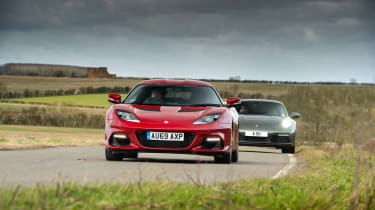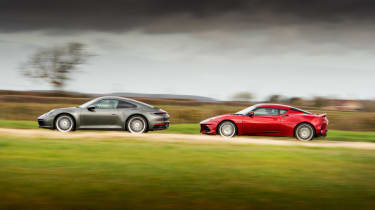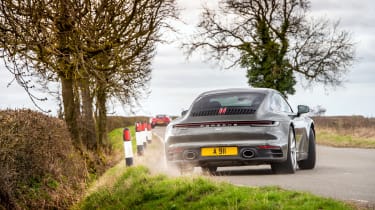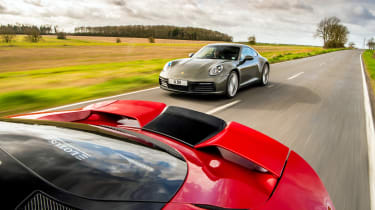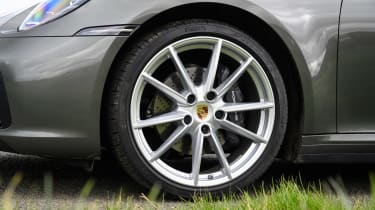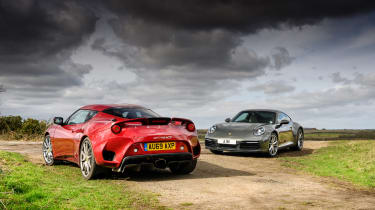Porsche 911 Carrera vs Lotus Evora GT410 – sports car showdown
These two 2+2 sports cars tread the line of thrills and everyday usability, but has the 992 compromised too much to beat the king of suppleness?
A year or two ago on these very pages, our learned colleague Richard Meaden mused on the subject of automotive monogamy: the idea of finding that one car you’d happily keep forever, rather than constantly flitting to the next fresh young thing that catches your eye.
Ask the average reader of this magazine to make such a choice and, with a generous budget, the Porsche 911 would probably feature on quite a few lists. It has the perfect confluence of characteristics you’d want to combine if never allowed another vehicle – performance, attractive styling, a desirable badge, driver involvement, and enough practicality to cover most eventualities.
Whatever the latest 992 might have lost to the 991 in some of those areas, it’s undoubtedly gained in others. I’d defy most people to spend a week in a 992 and not come away wishing there was one in their future. Other cars might feature, of course – the Alpine A110, BMW M3s, perhaps Porsche’s own Cayman – but the 992 would be a fine choice.
Lotus has always been there or thereabouts though, with Elites, Esprits and, for the last decade, the Evora. With the same cylinder count and tiny rear seats it’s clearly in the 911 ballpark, not least with its £82,900 price tag, exactly £105 more expensive than the most option-shy 992 Carrera you can possibly order.
The GT410 and basic Carrera, then, are the point at which Evora and 911 are closest. It’s the Evora at its most liveable and road biased, and the 911 at its simplest and least embellished. The former hasn’t become a luxury car and the 911 isn’t exactly a stripped-out 2.7 RS, but they both converge at what could be considered the perfect balance of involvement, useability and road-going performance.
More reviews
Group tests
In-depth reviews
Reviews
For the GT410 that has meant the reintroduction of some equipment the GT410 Sport omitted, and certain components exchanged for more suitable ones elsewhere. In comes sound-deadening material, a glass rear window in place of the solid panel of the Sport, and air conditioning, plus niceties such as armrests on the doors and heated seats. There’s even a rear-view camera, which is just as well given the view out the back is little better than it was with the opaque, slatted carbonfibre.
And out go the Cup 2s, with less extreme Pilot Sport 4 S tyres in their place, matched with softer damping for the otherwise identical springs. These arguably are the most significant changes from the Sport, as they’re the ones that should affect how the car actually drives. Not that this was something the Sport struggled with exactly, but as the Evora is the sensible, grown-up car of the Lotus range, it’s useful to now have the option of one with a broader window of useability.
The Carrera’s key appeal lies in its relative accessibility, as the 992’s objective limits climb ever higher. Finding a modern performance car’s sweet spot is often like playing pass the parcel, tearing away layer after layer of ability on every drive but with few guarantees you’ll get to the prize by the time you park up. As the slowest 992, and riding on the slimmest tyres, the Carrera is the model with the fewest layers of wrapping paper.
That’s the theory anyway, though predictably our 992 arrived with a few upgrades, among which were (you guessed it) 20- and 21-inch alloy wheels from a Carrera S, and the fatter rubber that results. Sigh. In the merit column: ‘only’ 380bhp and 332lb ft (64bhp and 59lb ft down on the Carrera S), standard brakes, no Sport Chrono. It’s about as basic as a modern 911 is likely to get, though Porsche will currently offer you a manual gearbox only on the Carrera S.
You do get one in the Evora, a six-speeder attached to the 410bhp and 295lb ft 3.5-litre Toyota-sourced and Lotus-supercharged V6, though there’s an auto option for the select few who need or desire it. That third pedal already feels like a small luxury at this level of the market, and it was undoubtedly a contributing factor to the Sport’s warm reception when it joined our 992 group test last year (evo 261). Another anachronism is Lotus’s use of hydraulic assistance for the steering, something you suspect isn’t budgetary but because the company’s engineers believe there’s no current way of delivering the same feedback with electric assistance.
It’s easy to get absorbed in these kinds of thoughts over the first few miles. It’s best for your sanity too, as it keeps you from noticing all the little things that make you question the GT410’s price and market position – the switches, vents and stalks from various mass-market hatchbacks, the shiny plastic dashboard inserts, the flimsy exterior door handles. Begone, foul thoughts. Concentrate instead on your forward view – nearly unmatched outside of the Lotus range itself – and it almost coerces you into sitting further forward than necessary to appreciate it even more vividly. As a bit of a short-arse I already need to slide the seat backwards and then forwards again every time I climb in, but the result is panoramic visibility and a feeling your feet are somewhere forward of the front axle, like being in a 1970s Le Mans racer. It sounds stranger than it feels – the sense of being within arm’s reach of the front wheels makes the Evora an instantly reassuring B-road partner.
And if you really could reach out and touch the front tyres, you’d get only marginally better feedback than the GT410’s steering offers. Two sensations dominate during the brief acclimatisation period. The first is that feeling familiar to all Lotuses since the original Elise, of the wheel gently writhing in your palms as the front wheels trace the surface below, gently responding to cambers and contours. The second is due to that cab-forward feel with the engine slung somewhere behind you, resulting in a bright and responsive front end trailed by a heavier mass that needs a little more effort to move.
It’s the polar opposite of thrusting front-engined machines that place you pendulum-like over the rear axle, and steer before your input has registered at the back wheels. In the Lotus the front steers, and the rear follows after a small but perceptible delay, almost as if it’s rear-engined rather than mid-engined. Not unlike an old 911 in fact, and as you spend more time with the GT410 you realise that a similar driving technique applies, using the brakes to keep weight over the front wheels, travelling a little slower mid-corner, and then making the most of the car’s traction to get hard on the power and fire rapidly out the other side.
In some respects it doesn’t matter how you go about cornering, as the sensations at your fingertips make it enjoyable whatever technique you’ve chosen. Even a touch of understeer is no big deal, as it’s telegraphed so quickly and with such clarity you can respond to it without a second thought.
Moments involving the throttle need a little more finesse. Supercharged engines are typically known for their linearity, and in most cases – with an exception that I’ll come to shortly – that’s what you’ll find with the Evora’s V6. A strong, linear delivery, building up towards peak power like a particularly healthy naturally aspirated unit.
You could mistake the sound for natural aspiration too. Supercharger whine is just about audible, but it’s a penny whistle at a Metallica concert compared to the exhaust note. From about the halfway point on the tacho needle’s sweep the noise that emanates from behind is hilariously loud. Strap the GT410 to the top of a cross-channel ferry and you could use it to ward off other ships in thick fog. Prod the exhaust button on the top bank of dashboard switches and it’ll make a similar noise from idle, while switching to Sport or Race mode has a similar effect.
The engine’s lively on the move. However, it’s curiously unresponsive to smaller throttle openings. I’ve a suspicion it’s to make it a little easier to live with when you’re creeping along in traffic, but a side effect is a reluctance to grant you downshift blips. You’ll tweak the pedal a few times to no avail, and then on your third attempt, the tiniest extra application of throttle sends the revs soaring and sets off car alarms in a five-mile radius.
The 911 feels like an island of calm after the Evora. Much more conventional, with seats you sink into rather than perching upon and good visibility in all directions rather than just directly in front. Both cars are 2+2s in name, but only in the Porsche would you entertain using the rear seats for smaller members of the family for any distance.
The 991 already began moving away from the intimacy of earlier cars with their narrow cockpits and windscreen at the end of your nose, and the latest car’s cabin is more expansive still. I’m quite fond of it, at least visually, with its retro-style lower ‘shelf’ to the dashboard and the mix of analogue tachometer (probably the most legible instrument of any modern car) and digital displays either side. There’s also an atmosphere to this particular car, with its Aventurine Green paintwork and light interior, that you’d lack with the default choices of silver and black.
If there’s one element that seems out of place, it’s located between the seats. Standard PDK means basic transmission duties are handled by a small plastic protrusion on the centre console. It’s no doubt space efficient and sophisticated, but it’s not nearly as satisfying to operate as the large pistol-grip item in the 991 and looks a bit like something you’d use to tidy a bikini line. The supporting metallic paddles behind the wheel bring little joy either, with a curved edge that your fingers never quite hook on to and a dull thud to their action. It strikes me that small details such as these will increasingly be the way to differentiate cars as electrification removes their mechanical character, so Porsche still has work to do in this area should it ever begrudgingly build an electric 911.
You won’t travel very far before discovering there’s still plenty to like about the 992, though. A couple of good corners should do it, enough to feel the buttery way that it transitions into, through and out of a turn, each and every component feeling like it’s working towards a common goal. It’s there in the Carrera’s 380bhp feeling like all the performance you’d realistically need from a 911 (it’s more than a 996.2 GT3, for reference), delivered with a smooth, responsive insistence whether you’re stepping off the line or seeking a hit of adrenaline before the next braking zone. The flat-six has naturally aspirated response and top-end zip, with bountiful turbocharged low- and mid-range torque, and for all its lack of theatre there’s no faulting the speed at which the PDK can flip from one gear to the next, up or down the ’box.
The polish is there under braking too, with pedal weighting and progression that gives you everything you need to judge your inputs. It’s certainly there once you deviate from a straight line, the steering slack-free, with linear response and informative changes in weight. Grip levels are ideally matched to the car’s performance, despite those bigger wheels, and malleable enough to let you appreciate a balance that feels more even than the Evora’s, despite the 911’s engine being further back; perhaps it’s a benefit of the six not being mounted at torso height, as in the Lotus.
It takes less mental capacity to drive the 992 than it does the Evora, but not necessarily in the sense that there’s anything missing, more that it behaves so faithfully it’s simply less mentally strenuous to exploit its capabilities. In fact, if you momentarily forget about such subjective matters as feedback and character, it could be dynamically perfect – the 992 won’t do anything you don’t expressly ask it to.
Still, you can step back into the Evora and discover what, seconds ago, you didn’t even realise the 911 was missing. Sure enough it’s littered with the kind of imperfections that would make a Porsche engineer openly weep. But what it does well, it does in a more flavoursome way than the 911. The steering talks to you more, even if the messages coming back reveal the car isn’t doing exactly what you’ve asked. The exhaust note can be annoying, but at least it’s there. And for every time you accidentally snag the gearshift in the detent for reverse as you’re changing down to second, there are a hundred more clackety mechanical movements that connect you far more to the V6 than the 992’s passionless paddles do with its own six-pot. If the two cars were cheese sandwiches, the 992 would use the highest-quality cheddar and the freshest bread, cut into neat little triangles with the crusts removed. Meanwhile grated cheese would be falling out the sides of the Evora sandwich, and the bread would have been hacked into doorstops by a maniac with a chainsaw, but Lotus would also have crammed it with pickles and pastrami. Like I said, flavour.
Don’t mistake this as suggesting that the Evora is a better car, because it isn’t. Its platform is getting on a bit these days and in purely objective terms the 992 Carrera has the measure of the GT410 on the road. I still don’t think there’s realistically a scenario in which you’d actually be disappointed by the 911 either. Using one every day, for every journey and in all possible conditions, would be a pleasure in a way I don’t quite think the Lotus could manage, which has probably always been the case with Porsches and their equivalents from Hethel.
But even if you’re still leaning towards the Lotus, if you can live without the ‘+2’ seating there’s an elephant in the room in the shape of Porsche’s 718 Cayman GTS, fresh onto the scene with the six-cylinder engine from the GT4 and a price tag £7500 below this pair’s. Every bit as interactive as the Lotus and damn near as polished as its bigger brother, it combines the best aspects of two of the most talented sports cars on sale. By definition that makes it even better, and automotive monogamists should probably look no further.

